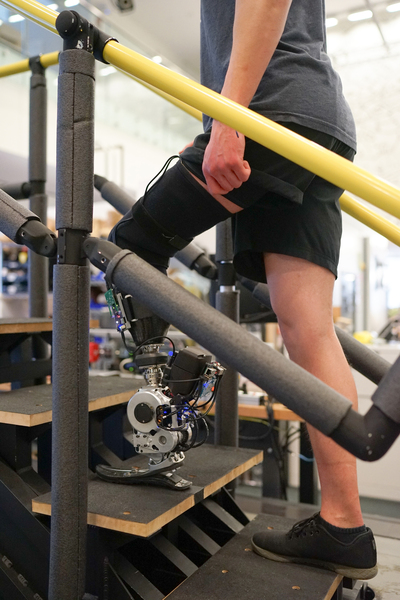With a new surgical intervention and neuroprosthetic interface, researchers restored a natural walking gait in people with amputations below the knee. Seven patients were able to walk faster, avoid obstacles, and climb stairs more naturally than people with a traditional amputation.
State-of-the-art prosthetic limbs can help people with amputations achieve a natural walking gait, but they don’t give the user full neural control over the limb. Instead, they rely on robotic sensors and controllers that move the limb using predefined gait algorithms.
Using a pioneering surgical intervention and advanced neuroprosthetic interface, MIT researchers, in collaboration with Brigham and Women’s Hospital, have demonstrated that a natural walking gait is achievable with a prosthetic leg fully controlled by the body’s nervous system. This innovative procedure, known as the agonist-antagonist myoneural interface (AMI), reconnects muscles in the residual limb, enabling “proprioceptive” feedback—allowing patients to sense the position of their prosthetic limb in space.
In a study involving seven patients who underwent this surgery, the MIT team observed significant improvements in walking speed, obstacle navigation, and stair climbing compared to traditional amputations. Patients also experienced reduced pain and muscle atrophy.
“This is the first prosthetic study in history that shows a leg prosthesis under full neural modulation, where a biomimetic gait emerges. No one has been able to show this level of brain control that produces a natural gait, where the human’s nervous system is controlling the movement, not a robotic control algorithm,” says Hugh Herr, a professor of media arts and sciences at MIT.
The researchers tested the subjects in several different situations: level-ground walking across a 10-meter pathway, walking up a slope, walking down a ramp, walking up and down stairs, and walking on a level surface while avoiding obstacles.
In all of these tasks, the people with the AMI neuroprosthetic interface were able to walk faster — at about the same rate as people without amputations — and navigate around obstacles more easily. They also showed more natural movements, such as pointing the toes of the prosthesis upward while going up stairs or stepping over an obstacle, and they were better able to coordinate the movements of their prosthetic limb and their intact limb. They were also able to push off the ground with the same amount of force as someone without an amputation.

“With the AMI cohort, we saw natural biomimetic behaviors emerge,” Herr says. “The cohort that didn’t have the AMI, they were able to walk, but the prosthetic movements weren’t natural, and their movements were generally slower.”
These natural behaviors emerged even though the amount of sensory feedback provided by the AMI was less than 20 percent of what would normally be received in people without an amputation.
“One of the main findings here is that a small increase in neural feedback from your amputated limb can restore significant bionic neural controllability, to a point where you allow people to directly neurally control the speed of walking, adapt to different terrain, and avoid obstacles,” Song says.
“This work represents yet another step in us demonstrating what is possible in terms of restoring function in patients who suffer from severe limb injury. It is through collaborative efforts such as this that we are able to make transformational progress in patient care,” says Matthew Carty, a surgeon at Brigham and Women’s Hospital and associate professor at Harvard Medical School, who is also an author of the paper.Enabling neural control by the person using the limb is a step toward Herr’s lab’s goal of “rebuilding human bodies,” rather than having people rely on ever more sophisticated robotic controllers and sensors — tools that are powerful but do not feel like part of the user’s body.
“The problem with that long-term approach is that the user would never feel embodied with their prosthesis. They would never view the prosthesis as part of their body, part of self,” Herr says. “The approach we’re taking is trying to comprehensively connect the brain of the human to the electromechanics.”
The research was funded by the MIT K. Lisa Yang Center for Bionics, the National Institute of Neurological Disorders and Stroke, a Neurosurgery Research Education Foundation Medical Research Fellowship, and the Eunice Kennedy Shriver National Institute of Child Health and Human Development.
The success of this procedure marks a monumental step in neuroprosthetics, demonstrating that enhanced neural feedback can significantly restore natural movement, moving closer to the goal of making prosthetics feel like an integral part of the user’s body.
Journal Reference:
- Hyungeun Song, Tsung-Han Hsieh, Seong Ho Yeon, Tony Shu, Michael Nawrot, Christian F. Landis, Gabriel N. Friedman, Erica A. Israel, Samantha Gutierrez-Arango, Matthew J. Carty, Lisa E. Freed, Hugh M. Herr. Continuous neural control of a bionic limb restores biomimetic gait after amputation. Nature Medicine, 2024; DOI: 10.1038/s41591-024-02994-9

